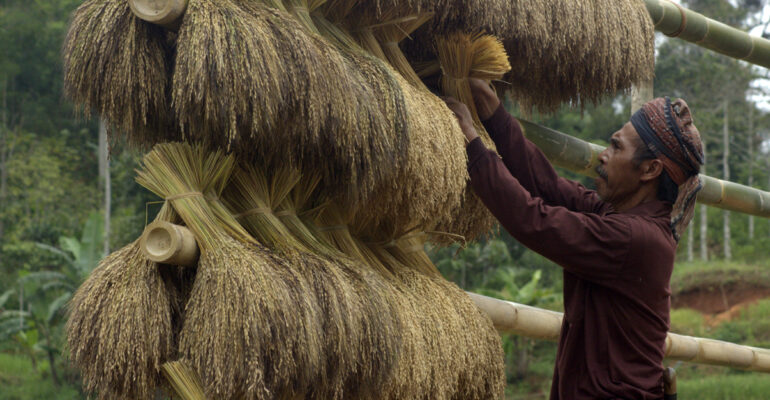IPB University Students: Ciptagelar Kasepuhan Farmers Used to Read Planting Seasonal Patterns, Now They Can’t

To determine planting season, Ciptagelar Kasepuhan (sultan’s place), Sukabumi, West Java saw the Kerti (Pleyades) and Kidang (Orion) stars in the morning around 03:00-04:00. According to the Kasepuhan’s chief, the seasonal patterns used to be readable in the past. There are dry year and wet year, as well as years with a lot of wind.
“Now, it’s not applicable anymore, sometimes it rains in the middle of a dry season. Sometimes the dry season lasts very long, even the rainy season lasts so long. The adaptive measure that the people of Ciptagelar Kasepuhan do is to change the rice variant with those which can resist dryness during an extended dry season and suitable to the type of each land available there” he said to IPB University students who were studying about climate change there.
In Indonesia, in the last 30 years, there are several extreme climates, indicated by the rising frequency of climate variability, causing disasters such as flood and drought. The crop failure phenomenon due to flood and drought has happened before in Indonesia, such as in Nusa Tenggara, Demak Regency, even West Java.
Such condition motivates Ahmad Juang Setiawan, Felia Rizky Aulia, and Cindi Amelini from Meteorology Major, Faculty of Mathematics and Natural Sciences (FMIPA) to conduct a study titled Responding to Climate Change with Local Wisdom (Mimpi Kekal). The study is supervised by Dr. Bambang Dwi Dasanto from Geophysics and Meteorology Department.
According to Ahmad, Kasepuhan Ciptagelar people can adapt to climate change using local wisdom. This area can achieve food independence in a local scale while the other communities suffer from crop failure due to hydrometeorological disasters, such as flood and drought. The agriculture system of Ciptagelar Kasepuhan consists of planting rice only once in a year, using organic fertilizer, and observing sky objects as a sign to determine the start of planting season.
The study funded by Ministry of Research, Technology and Higher Education (Kemenristekdikti), through Student Creativity Program (PKM) 2019, compares the start of planting seasons according to local wisdom of Ciptagelar Kasepuhan with the one determined by the rainfall data according to modern agriculture science.
“Our interview results with Ciptagelar Kasepuhan people show that 68 percent of the respondents said that there is an increase of tempereature, and 95 percent of them said that the rainy season shifts,” he said.
The results of this study show that in 2010 there is a similarity of the start of planting season between the one determined by local wisdom and the one determined by the modern calculation.
“In 2012 and 2017, kasepuhan people determine the start of planting season to be earlier one decade. In 2013 and 2014, earlier by two decades, in 2011 and 2014, three decades. In 2015, four decades. In 2009 and 2016, they determine the start of planting season to be later by two decades. This happens because the local wisdom always determines that the season comes at the same time every year, looking at the constellation, while the annual rainfall is always different. Besides that, there are also cultural activities done by the people to support their agriculture system,” he said. (Ard)



